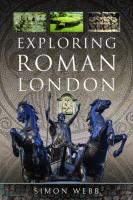
Pen & Sword (2023) p/b 236pp £16.99 (ISBN 9781399058490)
If you walk down Cousin Lane, to the west of Cannon Street station, you will reach the north bank of the Thames. Climb down a short flight of steps, and, if the tide is out, you will be on the foreshore. The Thames itself is a few metres away. Beneath your feet there are pebbles, seashells, potsherds, and pieces of broken terracotta tile.
Bend down, and look closely at the pebbles, shells, and tiles. Here is a piece of broken brick, its edges worn smooth by the river. Here is a small blue engineering brick. Here is a piece of irregularly-shaped red tile. Pick it up and examine it. If it is flat, with a flange at one side, you will be holding a piece of a tegula, a Roman roof tile. This was, almost certainly, part of the large Roman building which stood on the site of Cannon Street station.
I knew little about Roman London, and nothing about roof-tiles on the foreshore, until I read this book. W. writes with great enthusiasm about walking along the streets and alleyways in the modern City, and explaining how the layout of its roads and the location of its buildings are directly connected to the way that the Romans built their roads, villas, and temples. He tells you where the Roman streets and buildings were and shows you where you can see sections of Roman walls and pavements.
W.’s enthusiasm made me want to go and see for myself, and search the foreshore for pieces of Roman tile. Even if you have lived and worked in London all your life, you will see the layout of the streets in a different way. W. explains why the Romans settled on the site which became Londinium. They wanted a place where they could ford the river easily. They needed to be on a hill, which was easier to defend from their enemies. He shows us where the hills are, and where the rivers once ran, even if they are not immediately apparent in 2024. He takes us beyond the City to search for traces of Imperial Rome in Southwark, Westminster, Greenwich, and Orpington.
There are no written records of Roman London. Our knowledge is the result of years of work by archaeologists, which is why the traces of Roman life and civilisation are so important. W. explains why the best-preserved remains of the Roman city are in cellars. The level of the streets is roughly seven metres higher in 2024 than it was in AD 120. The Romans did not have skips. When they demolished a building, they left the rubble where it was, and built their new bath-house, or villa, on top of it.
W. tells the story of the Roman conquest of Britain, from Julius Caesar’s arrival in Kent in 55 BC, to the landing of the Emperor Claudius’ legions in AD 43, when Britain became a Roman colony. He explains how the Romans developed Londinium. He tells us that they built their bath-houses near rivers, to ensure a constant supply of water. Most of central London’s rivers, such as the Fleet and the Walbrook, now run underground, and the remains of Roman bath-houses show us where the rivers ran before they were turned into sewers. He guides us along the roads, such as Farringdon Road, which were once river valleys.
W.’s enthusiasm is infectious, and he makes me want to go on more walks and explore more of the ruins of Londinium. But it is a shame that there is only one sketch-map, showing the rivers of London in AD 43. A series of maps of the walks, showing the outline of the modern streets, with the outlines of Roman streets and Roman buildings in red, would have improved the book considerably, and added to the joy and understanding of twenty-first century explorers.
There are some errors. A ballista is not a catapult. Almost all the measurements are in yards or feet, which will baffle modern children. On p.78, Mr Webb says that by AD 110 AD ‘Roman culture had been found to be a good thing and the country was at peace.’ No-one who has read Sellar and Yeatman’s 1066 And All That will be able to read this without laughing, and I found myself adding Sellar and Yeatman’s Audible Capitals to ‘A Good Thing’. Finally, the book needed quite a lot of cutting. This would enhance it without losing any information, or any of W.’s infectious enthusiasm for his subject. I look forward to exploring more of Roman London.
Andrew McCarthy
